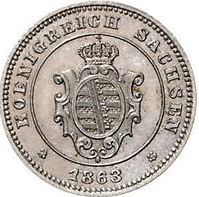
The Deutsche Mark, abbreviated "DM" or "D-Mark" ( ), was the official currency of West Germany from 1948 until 1990 and later the unified Germany from 1990 until the adoption of the euro in 2002. In English, it was typically called the "Deutschmark". One Deutsche Mark was divided into 100 pfennigs.

Groschen is the name for various coins, especially a silver coin used in parts of Europe such as France, some of the Italian states, England, various states of the Holy Roman Empire, among others. The word is borrowed from the late Latin description of a tornose, a grossus denarius Turnosus, in English the "thick denarius of Tours". Groschen was frequently abbreviated in old documents to gl, whereby the second letter was not an l, but an abbreviation symbol; later it was written as Gr or g.

The German mark was the currency of the German Empire, which spanned from 1871 to 1918. The mark was paired with the minor unit of the pfennig (₰); 100 pfennigs were equivalent to 1 mark. The mark was on the gold standard from 1871 to 1914, but like most nations during World War I, the German Empire removed the gold backing in August 1914, and gold coins ceased to circulate.

The Kreuzer, in English also spelled kreutzer, was a coin and unit of currency in the southern German states prior to the introduction of the German gold mark in 1871–1873, and in Austria and Switzerland. After 1760 it was made of copper. In south Germany the kreuzer was typically worth 4 pfennigs and there were 60 kreuzers to a gulden. Kreuzer was abbreviated as Kr, kr, K or Xr.

The Vereinsthaler was a standard silver coin used in most German states and the Austrian Empire in the years before German unification.
The Silbergroschen was a coin used in Prussia and several other German Confederation states in northern Germany during the 19th century, worth one thirtieth of a Thaler.

The Neugroschen was a Saxon Scheidemünze coin minted from 1841 to 1873 which had the inscription Neugroschen. This groschen, made of billon, was equivalent to the Prussian groschen but, unlike the latter, was divided not into 12, but into 10 pfennigs.

The Reichsthaler, or more specifically the Reichsthaler specie, was a standard thaler silver coin introduced by the Holy Roman Empire in 1566 for use in all German states, minted in various versions for the next 300 years, and containing 25–26 grams fine silver.

The Austro-Hungarian gulden was the currency of the lands of the House of Habsburg between 1754 and 1892, when it was replaced by the Austro-Hungarian krone as part of the introduction of the gold standard. In Austria, the gulden was initially divided into 60 kreuzers. The currency was decimalized in 1857, using the same names for the unit and subunit.
The South German Gulden was the currency of the states of Southern Germany between 1754 and 1873. These states included Bavaria, Baden, Württemberg, Frankfurt and Hohenzollern. It was divided into 60 kreuzer, with each kreuzer worth 4 pfennig or 8 heller.
The Prussian Thaler was the currency of Prussia until 1857. In 1750, Johann Philipp Graumann implemented the Graumannscher Fuß with 14 thalers issued to a Cologne Mark of fine silver, or 16.704 g per thaler.
The Vereinsthaler was the currency of Prussia between 1857 and 1873. It replaced the Thaler at par and was replaced by the Mark at a rate of 1 Vereinsthaler = 3 Mark. The Vereinsthaler was subdivided into 30 Silbergroschen, each of 12 Pfennings.
The Vereinsthaler was the currency of the Kingdom of Saxony between 1857 and 1873. It replaced the Thaler at par and was replaced by the Mark at a rate of 1 Vereinsthaler = 3 Mark. The Vereinsthaler was subdivided into 30 Neugroschen, each of 10 Pfennig.
The North German thaler was the currency of the Electorate and Kingdom of Saxony until 1857. Between 1754 and 1841, it was equal to three quarters of a Conventionsthaler and was subdivided into 24 Groschen, each of 12 Pfennig. In 1841, Saxony partially decimalized, dividing the Thaler into 30 Neugroschen, each of 10 Pfennig. The Thaler was replaced by the Vereinsthaler at par.
The Thaler was the currency of the Electorate, later Kingdom of Hanover until 1857. It was identical to the North German thaler except from 1754 to 1834 when it was worth 1/12 a Cologne Mark of fine silver. It was subdivided into 36 Mariengroschen, each of 8 Pfennig.
The Vereinsthaler was the currency of the two Grand Duchies of Mecklenburg-Schwerin and Mecklenburg-Strelitz between 1857 and 1873. It replaced the Mecklenburg Thaler at par and was replaced by the Mark at a rate of 1 Vereinsthaler = 3 Mark. The Vereinsthaler was subdivided into 48 Schillinge, each of 12 Pfenninge.
The Vereinsthaler was the currency of the Electorate of Hesse-Kassel between 1858 and 1873. It replaced the Thaler at par and was replaced by the German Mark at a rate of 1 Vereinsthaler = 3 Mark.
The North German thaler was the currency of the Landgravate, then Electorate of Hesse-Kassel until 1858. Until 1807, the Thaler was subdivided into 32 Albus, each of 12 Heller. It was worth 3⁄4th a Conventionsthaler from 1754 to 1841.
The Speciethaler was the currency of Schleswig-Holstein until 1866, located in the border region of present-day Denmark and Germany.

The history of Saxon coinage or Meissen-Saxon coinage comprises three major periods: the high medieval regional pfennig period, the late medieval pfennig period and the thaler period, which ended with the introduction of the mark in 1871/72. Rich silver deposits, which were discovered near Freiberg after the middle of the 12th century, helped Saxony to a leading position in German coinage.








